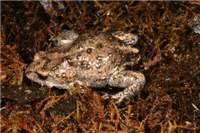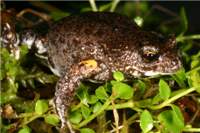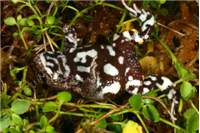Family
MyobatrachidaeGenus
PseudophryneSpecies
bibroniiThreats/Control Methods - Regional
It is not fully understood why the ACT population disappeared but there are several possible causes including habitat modification or disease such as the Chyrtid Fungus.
For more information on the Chytrid fungus © Link to fact sheet http://www.deh.gov.au/biodiversity/invasive/publications/c-disease/
Frogs drink and breathe through their skin and are very sensitive to chemicals in their environment. Where possible, you should not handle frogs, as the natural bacteria on your hands or chemicals such as sunscreen can damage their skin and cause illness or death.
Local/Urban Actions
Within the ACT Frogwatch, an annual frog monitoring program is run, with monitoring done by volunteers from the general public. The Frogwatch program provides training for community volunteers each October, with monitoring then being undertaken by volunteers over a two week period.For more information on Frogwatch contact:The ACT Frogwatch Coordinator, Ginninderra Catchment Group; Ph(02)62783309 oremail: [email protected]
It is also possible to promote urban backyards to frogs as suitable habitat, through simple landscaping techniques. The Australian National University and the Ginninderra Catchment Group have developed a guideline to help you encourage frogs into your backyard called [Link - Creating a Frog Friendly Habitat in the ACT Community]
Distinguishing Features
A small, 3cm in length, brown coloured frog, its back is covered in a wart-like lumps. The armpits of the forearms have a contrasting bright orange colour, the belly a pale off-white colour with black mottling.
Common name/s
Brown Toadlet, Birbon©s Toadlet
Similar Species
Northern Corrboree Frog (Pseudophryne pengilleyi), Southern Corroborre Frog (Pseudophryne corroboree), Southern Toadlet (Pseudophryne dendyi).
Distribution
Southeastern South Australia, through Victoria , Tasmania, Coastal and Inland NSW, Southern QLD
Country of Origin
Australia
Survey Techniques
Due to the small size of the frog and the camouflaging nature of its skin, the easiest and safest way to detect the species is call identification.
Conservation (Pet/Pest) Status - National
Not currently listed as under threat.
Conservation (Pet/Pest) Status - Regional
Not currently listed as under threat.
LSCCES Population
Although previously occurred in the ACT the species is now thought to be locally extinct.
Associated Vegetation Community
Inhabits a wide variety of habitats including wet coastal areas, inland habitats, lowlands and mountains. Prefers to be near static water bodies, such as puddles or ponds, either temporary or permenant.
Limiting Resources
The species appears to require soils with a low pH in order for successful hatching of eggs.
Behaviour
Eggs are laid in depressions in soil under ground cover, such as leaf litter. When water reaches such sites, for instance after a rainfall event, the eggs hatch and the tadpoles within swim to more permanent water bodies.
Functional Group
Insectivore
Food Species
Springtails (Collembola), beetles (Coleoptera), ants (Formicidae) and millipedes (Diplopoda) make up a substantial portion of their diet.
Predators
Tiger Snake (Notechis scutatus), Black Snake (Pseudechis porphyriacus)
Interesting Fact
Egg hatching of this species can be delayed in response to the external environment, for instance tadpoles can hatch after 1, or up to 100, days after being laid.
References - (reader suitability of references, P=Primary teachers, S=Secondary students, T=Tertiary students and researchers)
Journals:
Chambers, J.et al (2006). Soil pH influences embryonic survival in Pseudophryne bibronii (Anura: Myobatrachidae ). Austral Ecology. 31:68-75. T
Heatwole, H. et al. (1995). Faunal Survery of New England. I.V. the Frogs. Memoirs of the Queensland Museum. 38(1):229-249. T
Museum Victoria. (2005). Frogs of Victoria series: Birbon©s Toaldet, Pseudophryne bibronii. Information Sheet No.10151. P,S,T
Osborne, W. (1991). Declining frog populations and extinctions in the Canberra Region. Bogong. 11(4):4-7. S,T
Pengilley, R. (1971). The food of some Australian anurans (Amphibia). J,Zool., Lond. 163:93-103. S,T
Shine,R. (1977). Habits, diets, and sympatry in snakes: a study from Australia. Can. J. Zool. 55: 1118-1128. S,T
Books:
Tyler, M. (1994.) Australian Frogs: a natural history. Reed New Holland. Sydeny, Australia. S,T
Internet Resources:
NSW Department of Natural Resources, The Frogs of NSW Wetlands - Other Frogs. Accessed 1July 2006. Available online:
http://www.dlwc.nsw.gov.au/care/wetlands/facts/paa/frogs/other_frogs.html#BibronsToadlet P,S
Frogs Australia Network, Pseudophryne bibronii, Accessed 1 July 2006.
Available online:
http://frogsaustralia.net.au/frogs/display.cfm?frog_id=72 P,S



 Top
Top Top
Top